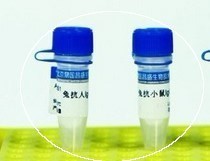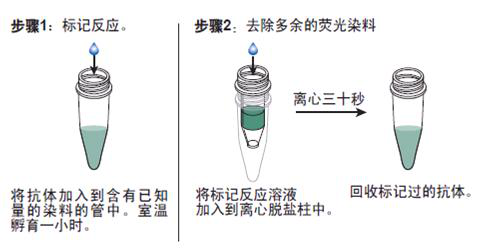
|

| 产地 | 进口、国产 |
| 品牌 | 上海莼试 |
| 保存条件 | Store at -20 °C |
| 货号 | CS11452 |
| 应用范围 | WB=1:100-500 ELISA=1:500-1000 IHC-P=1:100-500 IHC-F=1:100-500 IF=1:100-500 |
| CAS编号 | |
| 抗体名 | Anti-Thrombin Activation peptide fragment 1 |
| 克隆性 | |
| 靶点 | 详见说明书 |
| 适应物种 | 详见说明书 |
| 形态 | 详见说明书 |
| 宿主 | 详见说明书 |
| 亚型 | IgG |
| 标识物 | 详见说明书 |
| 浓度 | 1mg/1ml% |
| 免疫原 | KLH conjugated synthetic peptide derived from human Thrombin Activation peptide fragment 1 |
抗体的生物素化标记实验要点:
1. 凝血酶(凝血因子II)激活肽1抗体说明书 如在反应混合液中有叠氮钠或游离氨基存在,会抑制标记反应。因此,蛋白质在反应前要对 0.1mol/L碳酸氢钠缓冲液或0.5mol/L硼酸缓冲液充分透析;
2.所用的NHSB及待生物素化蛋白质之间的分子比按蛋白质表面的ε-氨基的密度会有所不同,选择不当则影响标记的效率,应先用几个不同的分子比来筛选最适条件;
3.用NHSB量过量也是不利的,抗原的结合位点可能因此被封闭,导致抗体失活;
4.由于抗体的氨基不易接近可能造成生物素化不足,此时可加入去污剂如 Triton x-100, Tween20等;
5.当游离ε-氨基(赖氨酸残基的氨基)存在于抗体的抗原结合位点时,或位于酶的催化位点时,生物素化会降低或损伤抗体蛋白的结合力或活性;
6.生物素还可能与不同的功能基团,如羰基、氨基、巯基、异咪唑基及*基,也可与糖基共价结合;
7.交联反应后,应充分透析,否则,残余的生物素会对生物素化抗体与亲和素的结合产生竞争作用;
8.在细胞的荧光标记实验中,中和亲和素的本底低,但由于链霉亲和素含有少量正电荷,故对某些细胞可导致高本底。
产品订购信息:
英文名称 Anti-Thrombin Activation peptide fragment 1
中文名称 凝血酶(凝血因子II)激活肽1抗体说明书
别 名 Activation peptide fragment 1; coagulation factor II; prothrombin; F2; Cf-2; Cf2; FII; F 2; coagulation factor II (thrombin); Coagulation factor II; Coagulation factor II precursor; F2; Factor II; Factor-II; Prothrombin; prothrombin B-chain; PT; serine protease; THRB; THRB_HUMAN; Thrombin.


浓 度 1mg/1ml
规 格 0.1ml/100μg 0.2ml/200μg
抗体来源 Rabbit
克隆类型 polyclonal
交叉反应 Human, Mouse, Rat, Guinea Pig
产品类型 一抗
研究领域 心 细胞生物 激酶和磷酸酶 合成与降解
蛋白分子量 predicted molecular weight: 17/64kDa
性 状 Lyophilized or Liquid
免 疫 原 KLH conjugated synthetic peptide derived from human Thrombin Activation peptide fragment 1
亚 型 IgG
纯化方法 affinity purified by Protein A
储 存 液 Preservative: 15mM Sodium Azide, Constituents: 1% BSA, 0.01M PBS, pH 7.4
凝血酶(凝血因子II)激活肽1抗体说明书 产品应用 WB=1:100-500 ELISA=1:500-1000 IHC-P=1:100-500 IHC-F=1:100-500 IF=1:100-500
(石蜡切片需做抗原修复)
not yet tested in other applications.
optimal dilutions/concentrations should be determined by the end user.
保存条件 Store at -20 °C for one year. Avoid repeated freeze/thaw cycles. The lyophilized antibody is stable at room temperature for at least one month and for greater than a year when kept at -20°C. When reconstituted in sterile pH 7.4 0.01M PBS or diluent of antibody the antibody is stable for at least two weeks at 2-4 °C.
Important Note This product as supplied is intended for research use only, not for use in human, therapeutic or diagnostic applications.
产品介绍 Thrombin is the final protease in the blood coagulation cascade and serves both pro- and anticoagulant functions through the cleavage of several targets. The ability of thrombin to specifically recognize a wide range of substrates derives from interactions which occur outside of the active site of thrombin. Thrombin possesses two anion binding exosites which mediate many of its interactions with cofactors and substrates, and although many structures of thrombin have been solved, few such interactions have been described in molecular detail. Glycosaminoglycan binding to exosite II of thrombin plays a major role in switching off the procoagulant functions of thrombin by mediating its irreversible inhibition by circulating serpins and by its binding to the endothelial cell surface receptor thrombomodulin.
Function : Thrombin is an active enzyme in the earliest steps of the blood clot formation, generated from its circulating inactive precursor prothrombin. Thrombin is a glycoprotein formed by two peptides chains of 36 and 259 amino acids linked by disulfure bonds. Three important sites have been identified on the surface of the enzyme: The catalytic site that confers to the molecule its serine protease activity, the exosite one responsible for the binding of the substrate (fibrinogen or thrombin receptor) and the exosite two responsible for the binding of antithrombin III and inactivation of thrombin. Gamma Thrombin is a proteolyzed form of Alpha Thrombin. Gamma Thrombin consists of four chains (A, B1, B5, B4) with a disulfide link between the A peptide and the B5 peptide.
Subunit : Heterodimer (named alpha-thrombin) of a light and a heavy chain; disulfide-linked. Forms a heterodimer with SERPINA5.
Subcellular Location : Secreted, extracellular space.
Tissue Specificity : Expressed by the liver and secreted in plasma.
Post-translational modifications : The gamma-carboxyglutamyl residues, which bind calcium ions, result from the carboxylation of glutamyl residues by a microsomal enzyme, the vitamin K-dependent carboxylase. The modified residues are necessary for the calcium-dependent interaction with a negatively charged phospholipid surface, which is essential for the conversion of prothrombin to thrombin.
N-glycosylated. N-glycan heterogeneity at Asn-121: Hex3HexNAc3 (minor), Hex4HexNAc3 (minor) and Hex5HexNAc4 (major). At Asn-143: Hex4HexNAc3 (minor) and Hex5HexNAc4 (major).
DISEASE : Factor II deficiency (FA2D) [MIM:613679]: A very rare blood coagulation disorder characterized by mucocutaneous bleeding symptoms. The severity of the bleeding manifestations correlates with blood factor II levels. Note=The disease is caused by mutations affecting the gene represented in this entry.
Ischemic stroke (ISCHSTR) [MIM:601367]: A stroke is an acute neurologic event leading to death of neural tissue of the brain and resulting in loss of motor, sensory and/or cognitive function. Ischemic strokes, resulting from vascular occlusion, is considered to be a highly complex disease consisting of a group of heterogeneous disorders with multiple genetic and environmental risk factors. Note=Disease susceptibility is associated with variations affecting the gene represented in this entry.
Thrombophilia due to thrombin defect (THPH1) [MIM:188050]: A multifactorial disorder of hemostasis characterized by abnormal platelet aggregation in response to various agents and recurrent thrombi formation. Note=The disease is caused by mutations affecting the gene represented in this entry. A common genetic variation in the 3-prime untranslated region of the prothrombin gene is associated with elevated plasma prothrombin levels and an increased risk of venous thrombosis.
Pregnancy loss, recurrent, 2 (RPRGL2) [MIM:614390]: A common complication of pregnancy, resulting in spontaneous abortion before the fetus has reached viability. The term includes all miscarriages from the time of conception until 24 weeks of gestation. Recurrent pregnancy loss is defined as 3 or more consecutive spontaneous abortions. Note=Disease susceptibility is associated with variations affecting the gene represented in this entry.
Similarity : Belongs to the peptidase S1 family.
Contains 1 Gla (gamma-carboxy-glutamate) domain.
Contains 2 kringle domains.
Contains 1 peptidase S1 domain.
Database links : UniProtKB/Swiss-Prot: P00734.2

抗体的鉴定:
1)凝血酶(凝血因子II)激活肽1抗体说明书 抗体的效价鉴定:不管是用于诊断还是用于,制备抗体的目的都是要求较高效价。不同的抗原制备的抗体,要求的效价不一。鉴定效价的方法很多,包括有试管凝集反应,琼脂扩散试验,酶联免疫吸附试验等。常用的抗原所制备的抗体一般都有约成的鉴定效价的方法,以资比较。如制备抗抗体的效价,一般就采用琼脂扩散试验来鉴定。
2)抗体的特异性鉴定:抗体的特异性是指与相应抗原或近似抗原物质的识别能力。抗体的特异性高,它的识别能力就强。衡量特异性通常以交叉反应率来表示。交叉反应率可用竞争抑制试验测定。以不同浓度抗原和近似抗原分别做竞争抑制曲线,计算各自的结合率,求出各自在IC50时的浓度,并按公式计算交叉反应率。
如果所用抗原浓度IC50浓度为pg/管,而一些近似抗原物质的IC50浓度几乎是无穷大时,表示这一抗血清与其他抗原物质的交叉反应率近似为0,即该血清的特异性较好。
3)抗体亲和力:是指抗体和抗原结合的牢固程度。亲和力的高低是由抗原分子的大小,抗体分子的结合位点与抗原决定簇之间立体构型的合适度决定的。有助于维持抗原抗体复合物稳定的分子间力有氢键,疏水键,侧链相反电荷基因的库仑力,范德华力和空间斥力。亲和力常以亲和常数K表示,K的单位是L/mol。抗体亲和力的测定对抗体的筛选,确定抗体的用途,验证抗体的均一性等均有重要意义。

Anti-SLK/Fyn/FITC 荧光素标记酪氨酸蛋白激酶Fyn(同步原癌基因)抗体IgGMulti-class antibodies规格: 0.2ml
Caspase-1 (ICE; CASP-1;P45) 天冬氨酸-胱氨酸特异性蛋白酶家族(抗原)Multi-class antibodies规格: 0.5mg
核因子2相关因子2抗体 Anti-Nrf2 0.1ml
pan 14-3-3 英文名称: 14-3-3蛋白抗体 0.2ml
EMP3 英文名称: 上皮细胞膜蛋白3抗体 0.2ml
Rhesus antibody Rh phospho-p107/RBL1(Ser975) 磷酸化视网膜母细胞瘤样蛋白p107抗体 规格 0.1ml
Caspase-1 (ICE; CASP-1;P45) 天冬氨酸-胱氨酸特异性蛋白酶家族(抗原)Multi-class antibodies规格: 0.5mg
Anti-TIF1 beta/KAP1/FITC 荧光素标记转录中介因子Tif1β抗体IgGMulti-class antibodies规格: 0.2ml
NOS-3 (eNOS) endotheli cell NOS 合成酶-3(抗原)Multi-class antibodies规格: 0.5mg
微管相关蛋白抗体 Anti-Tau protein 0.1ml
phospho-STXBP1 (Ser515) 英文名称: 磷酸化神经突触前膜胞内蛋白抗体 0.1ml
phospho-Ephrin B (Ser300) 英文名称: 磷酸化Ephrin B抗体 0.1ml
Rhesus antibody Rh phospho-LLGL1 + LLGL2(Ser650+Ser654) 磷酸化相似抑制基因HUGL抗体 规格 0.1ml
NOS-3 (eNOS) endotheli cell NOS 合成酶-3(抗原)Multi-class antibodies规格: 0.5mg
Mtp53(Mutant type p53) 突变型P53抗原Multi-class antibodies规格: 0.5mg
Anti-ASPP2/p53BP2 P53凋亡刺激蛋白2抗体Multi-class antibodies规格: 0.2ml
Rhesus antibody Rh phospho-AQP2(Ser261) 磷酸化水通道蛋白2抗体 规格 0.1ml
tau 浓缩液 0.1ml 进口分装
Ube2L3 英文名称: 泛素蛋白连接酶L3抗体 0.2ml
DHRS7 英文名称: 视网膜短链脱氢酶/还原酶家族7抗体 0.2ml
Anti-ASPP2/p53BP2 P53凋亡刺激蛋白2抗体Multi-class antibodies规格: 0.2ml
IL21 Protein Rat 重组大鼠 IL21 / Ierleukin 21 蛋白 (His 标签)
胰蛋白酶(含10mL 酶解缓冲液) 1mL
HA Others H5N1 甲型 H5N1 (A/Cambodia/S1211394/2008) 血凝素HA1 (Hemagglutinin) 人细胞裂解液 (阳性对照)
U-373MG-EGFP-puro[U-373MG-pLVT7](慢病毒构建稳定株)人 U-373MG-EGFP-puro[U-373MG-pLVT7] (leiviral consuct stable sain) of human brain glioma cells 1640+10%Hyclone 灭活血清+2μg/ml puromycin
CM-H020人胰岛β细胞完全培养基100mL
人表皮角质细胞-新生儿(HEK-n)( 5×105 ) 细胞名称 种属
CM-H092人脉络膜细胞完全培养基100mL
KIR2DL1 Others Human 人 KIR2DL1 / CD158a 人细胞裂解液 (阳性对照)
小鼠晶状体上皮细胞完全培养基 100mL
OPM-2-UBC-EGFP(稳定株)人细胞 OPM-2-UBC-EGFP (stable sain) human myeloma cell 1640+20% FBS(热灭活)
IL17F Protein Human 重组人 IL-17F / Ierleukin-17F 蛋白 (His 标签)
人雪旺细胞 ( HSC) ( 5×105 ) 小鼠神经干细胞 Mouse
凝血酶(凝血因子II)激活肽1抗体说明书 IL21 Protein Rat 重组大鼠 IL21 / Ierleukin 21 蛋白 (His 标签)
胰蛋白酶(含10mL 酶解缓冲液) 1mL
HA Others H5N1 甲型 H5N1 (A/Cambodia/S1211394/2008) 血凝素HA1 (Hemagglutinin) 人细胞裂解液 (阳性对照)
U-373MG-EGFP-puro[U-373MG-pLVT7](慢病毒构建稳定株)人 U-373MG-EGFP-puro[U-373MG-pLVT7] (leiviral consuct stable sain) of human brain glioma cells 1640+10%Hyclone 灭活血清+2μg/ml puromycin
CM-H020人胰岛β细胞完全培养基100mL
人表皮角质细胞-新生儿(HEK-n)( 5×105 ) 细胞名称 种属